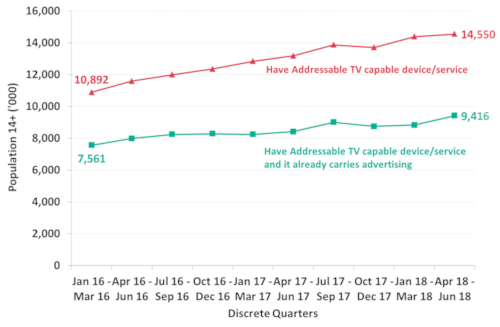Addressable TV advertising technology already reaches over 9 million Australians
Sunday, August 26th, 2018
Addressable TV advertising technologies allow advertisers to selectively segment TV audiences and serve different ads or adpods (groups of ads) within a common program or navigation screen.
New research from Roy Morgan shows that over 9 million Australians are already using the devices and services that this kind of technology requires like smart TVs, and streaming devices. However, broadcasters are only just starting to mature their own technologies and data stacks to be able to leverage connected devices such as smart TVs, streaming and set top boxes to deliver personalised advertising.
When one considers the increasing popularity of SVOD services such as Netflix and Stan covered in detail here, as well as free streaming services such as ABC iView that also have the potential to allow addressable TV but don’t allow advertising, over 14 million Australians today already watch content through devices which have the potential to carry addressable TV.

However, although the potential audience for addressable TV is already huge, and growing, there are still significant technical, data-related and investment hurdles for traditional broadcasters to overcome to fully exploit the commercial advantages that addressable TV can provide.
For popular streaming services such as Netflix, Stan and ABC iView their current business models do not carry any advertising either relying on a subscription based or freely offered service. However, these policies could well change in time. In just the last week Netflix has begun testing 30 second ads to advertise new content appearing on the service.
The services Australians already watch and which are used by over 9 million Australians that have the potential to deliver addressable TV today include Foxtel, Foxtel Now, Foxtel on Demand, Fetch, Google Play, 9Now, SBS on Demand, TENplay and 7Plus.
Including additional services that have the potential to deliver addressable TV but due to business decisions don’t currently carry advertising and are watched by over 14.5 million Australians include Netflix, Stan, ABC iView, Quickflix, Ozflix, Bigpond movies, Dendy Direct, iTunes (Movies & TV shows), Sports streaming, YouTube Premium and Amazon Prime Video.
Michele Levine, CEO, Roy Morgan, says the rise of digital advertising has provided a huge disruption to the media industry and traditional broadcasters are now fighting back against digital competitors and upgrading their services to take advantage of the new technologies:
“The rise of digital advertising has dominated the media landscape in recent years. It now represents a majority of the $16 billion+ Australian advertising market up from virtually nothing two decades ago.
“The attraction of digital advertising has increasingly revolved around the ability to advertise directly and to selecting targeted consumers with one-to-one marketing that traditional media has until now been unable to offer.
“The driving force behind ‘Addressable TV’ advertising technology is that it allows traditional media, and most particularly Australia’s TV broadcasters, to identify and target individuals and households based on specific criteria and deliver tailored advertising – just like digital advertising does.
“Addressable TV gives traditional Australian commercial TV broadcasters such as the Nine Network, Seven Network, Network Ten and Pay TV provider Foxtel the potential to compete on a level playing field with newer digital competitors such as Netflix, Amazon, Facebook, YouTube and others.
“New research from Roy Morgan shows that over 9 million Australians today have technology that could be utilised by addressable TV technologies to serve different ads when Australian broadcasters overcome the significant technical, data-related and investment hurdles that still remain to be overcome.
“When one considers the phenomenal growth of SVOD services such as Netflix and Stan, covered in detail here, and the popular ABC iView, that also have the potential to carry addressable TV but don’t currently as these services do not carry advertising, well over 14 million Australians could be served addressable TV tomorrow.
“In addition, the ubiquitious nature of advanced digital devices across the Australian marketplace means over 95% of Australians technically have addressable TV capable devices* that for whatever reason are not currently configured for the service.
“The increasingly fast rate at which Australians adopt a multitude of new technologies does give great hope to traditional broadcasters developing addressable TV as a viable competitor to newer digital-centred services. Australians have shown an increasing willingness to try out new technologies and all the evidence from the marketplace shows that if done correctly addressable TV can be a formidable step forward for traditional broadcasters.”
* A full list of devices and services, including apps, that are technically able to carry addressable TV and are measured in detail by Roy Morgan include Foxtel, Foxtel Now, Foxtel on Demand, Netflix, Stan, Quickflix, Ozflix, Fetch, Bigpond movies, Dendy Direct, Google Play, iTune (Movies & TV Shows), Sports streaming, ABC iView, 9 Now, SBS on Demand, TENplay, YouTube Premium, Amazon Prime Video, 7 Plus, 9Now, BBC iPlayer, Freeview FV, AFL Live Official App, Footy Live (AFL), Racing.com, YouTube and Australians with Smart TVs, smartphones, Games consoles such as Xbox, Playstation & Nintendo, Apple TVs, Fetch TVs, Google Chromecasts, Rokus, T-boxes, Telstra TVs and TiVos and those Australians who pay to access sporting events on demand, pay to access movies on demand, do shopping and access information on goods and services through my TV, make video calls through my TV, use my TV to access the Internet, use my TV to download apps and set up my TV recording via the Internet.
Latest News
- Nexxen empowers Australian advertisers using VIDAA ACR data
- TargetVideo integrates AI for video content categorization
- Meta opens Quest OS to third-party hardware makers
- Aferian to implement further cost reductions at Amino
- Paramount to exclusively represent SkyShowtime advertising sales
- Sky Sports Main Event latency reduced on Entertainment OS devices